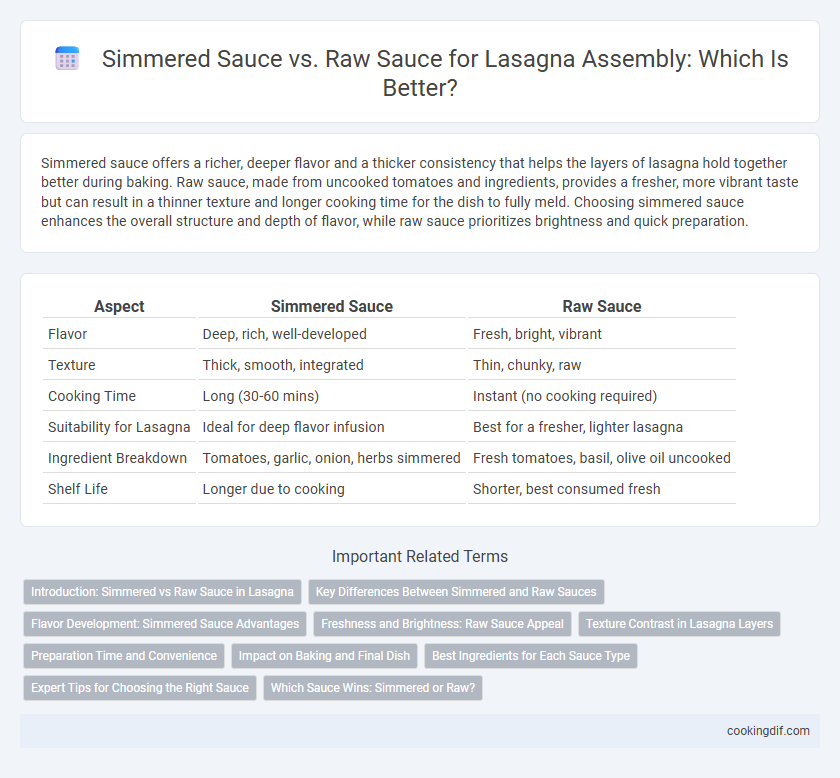Simmered sauce offers a richer, deeper flavor and a thicker consistency that helps the layers of lasagna hold together better during baking. Raw sauce, made from uncooked tomatoes and ingredients, provides a fresher, more vibrant taste but can result in a thinner texture and longer cooking time for the dish to fully meld. Choosing simmered sauce enhances the overall structure and depth of flavor, while raw sauce prioritizes brightness and quick preparation.
Table of Comparison
| Aspect | Simmered Sauce | Raw Sauce |
|---|---|---|
| Flavor | Deep, rich, well-developed | Fresh, bright, vibrant |
| Texture | Thick, smooth, integrated | Thin, chunky, raw |
| Cooking Time | Long (30-60 mins) | Instant (no cooking required) |
| Suitability for Lasagna | Ideal for deep flavor infusion | Best for a fresher, lighter lasagna |
| Ingredient Breakdown | Tomatoes, garlic, onion, herbs simmered | Fresh tomatoes, basil, olive oil uncooked |
| Shelf Life | Longer due to cooking | Shorter, best consumed fresh |
Introduction: Simmered vs Raw Sauce in Lasagna
Simmered sauce in lasagna develops deeper flavors through slow cooking, enhancing the richness of tomatoes, herbs, and aromatics. Raw sauce, often made from fresh tomatoes and minimal cooking, preserves a vibrant, tangy taste and lighter texture. Choosing between simmered and raw sauce influences the lasagna's overall flavor profile and moisture content.
Key Differences Between Simmered and Raw Sauces
Simmered sauce for lasagna develops richer, deeper flavors as ingredients like tomatoes, garlic, and herbs meld over time, creating a thick, well-integrated texture ideal for layering. Raw sauce, often fresher and lighter, retains a brighter tomato taste and requires less cooking time, lending a more vibrant contrast in the final dish. The choice between simmered and raw sauce affects the lasagna's overall moisture, flavor complexity, and how the sauce interacts with pasta and cheese during baking.
Flavor Development: Simmered Sauce Advantages
Simmered sauce enhances lasagna by allowing complex flavors to develop through prolonged cooking, which melds the acidity of tomatoes with aromatic herbs and spices. This slow simmering process breaks down raw ingredients and intensifies the sauce's richness, creating a deeper, more balanced taste compared to raw sauce. As a result, simmered sauce imparts a robust, harmonious flavor foundation that elevates the overall dish.
Freshness and Brightness: Raw Sauce Appeal
Raw sauce in lasagna assembly preserves the freshness and brightness of vine-ripened tomatoes, enhancing the dish with vibrant, natural flavors that simmered sauces can mellow out. Using uncooked sauce allows the herbs and spices to maintain their aromatic intensity, delivering a crisp and lively contrast to rich cheese layers. This approach highlights the authentic, garden-fresh essence that defines traditional Italian lasagna.
Texture Contrast in Lasagna Layers
Simmered sauce in lasagna develops a rich, velvety texture that melds seamlessly with pasta layers, enhancing moisture and depth. Raw sauce preserves bright, fresh tomato flavors and a slightly firmer, chunkier consistency, creating a distinct contrast against soft cheese and tender noodles. This interplay between simmered and raw sauces results in a dynamic texture contrast, elevating the overall sensory experience.
Preparation Time and Convenience
Simmered sauce requires longer preparation time, often taking 30 to 60 minutes to develop rich, deep flavors through slow cooking. Raw sauce, typically made from fresh tomatoes, herbs, and olive oil, offers greater convenience, as it can be assembled quickly without cooking beforehand. Choosing simmered sauce enhances taste complexity, while raw sauce prioritizes speed and freshness for lasagna assembly.
Impact on Baking and Final Dish
Simmered sauce enhances lasagna by deepening flavors and reducing excess moisture, ensuring a rich, well-balanced dish with a tender texture. Raw sauce can release more water during baking, potentially leading to a watery lasagna and uneven cooking. Choosing simmered sauce improves the baking process by minimizing sogginess and intensifying the overall flavor profile.
Best Ingredients for Each Sauce Type
Simmered sauce for lasagna benefits from slow-cooked tomatoes, fresh garlic, onions, and herbs like basil and oregano, which develop deep, rich flavors through prolonged heat. Raw sauce, often made with ripe, uncooked tomatoes, fresh basil, garlic, and high-quality olive oil, relies on the freshness and natural acidity of ingredients to create a bright, vibrant taste. Using premium San Marzano tomatoes for simmered sauce and vine-ripened Roma tomatoes for raw sauce enhances the distinct flavor profiles ideal for each preparation method.
Expert Tips for Choosing the Right Sauce
Simmered sauce enhances lasagna by developing deeper flavors through slow cooking, allowing tomatoes, herbs, and spices to meld harmoniously, while raw sauce offers a fresher, more vibrant taste with distinct ingredient notes. Experts recommend simmered sauce for traditional, richly layered lasagna varieties, as its thickened texture prevents excess moisture and sogginess during baking. For lighter, vegetable-focused lasagnas, raw sauce provides brightness and acidity, balancing creamy cheeses and pasta layers without overpowering subtler elements.
Which Sauce Wins: Simmered or Raw?
Simmered sauce wins for lasagna assembly due to its rich, developed flavors and thicker consistency that prevents sogginess between pasta layers. Raw sauce, while bright and fresh, often lacks depth and can release excess moisture during baking, compromising texture. Chefs prefer simmered sauce to achieve a balanced, hearty dish with optimal moisture control.
Simmered sauce vs Raw sauce for assembly Infographic

 cookingdif.com
cookingdif.com